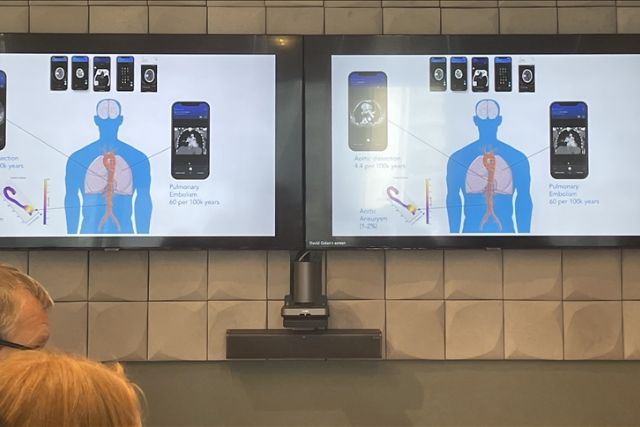Wearable tech and portable imaging devices to revolutionize medical sector
Technologies, including tablet-integrated ultrasound software and data collection devices that can be worn on the wrist and chest allow long-term monitoring

TEL AVIV
The largest and most comprehensive hospital in Israel, the Tel Avid-based Sheba Medical Center, is actively putting medical innovation at the heart of its mission to transform healthcare delivery and improve patient care.
In a workshop organized by the European Israel Press Association (EIPA), journalists from Europe and Türkiye witnessed the results of the center's approach in offering many start-ups the opportunity to develop medical technologies through collaboration.
The Center launched ARC, (accelerate, redesign, and collaborate), a global ecosystem that aims to develop, pilot, and roll out game-changing solutions like wearable technology, along with software and portable imaging devices that prevent unnecessary drug administration.
The workshop showcased studies by two companies, Ultrasight and AİSAP that developed technology in the cardiology field. New ultrasound software technology integrated into a tablet, as opposed to conventional, bulky ultrasound machinery, will enable speedy and efficient patient examination.
Data and images recorded with the software will then be shared with the appropriate specialist in digital format to allow for rapid patient intervention and treatment.
The start-up Seamless Vision will expand the development of pharmaceutical transport robots to perform logistics services quickly in large-scale hospitals.
The robot, with an integrated map, camera system and device software, can easily navigate to the targeted area to dispense medicine and equipment, etc. with an integrated map.
The company wants to enlarge the number of robots to 100 and expand their deployment through international cooperation.
Small devices focus on immediate patient intervention
With data collection devices developed by medical imaging company, Biobeat, heart rates, body temperature, blood oxygen saturation levels, respiratory rates and blood pressure can be monitored for lengthy periods on wearable watch-like devices placed either on the wrist or chest area.
In case of emergencies, the nearest hospital, institution, or doctor to whom the device is accredited can be contacted for immediate intervention if necessary. The device offers physicians a wide range of data for diseases that require constant observation through the recorded patient data map.
The Scopio Laboratory has developed technology in the field of hematology to scan and examine blood samples that are difficult to scrutinize through a microscope. Thanks to this software, cancerous cells can be detected more rapidly than those through a microscope, speeding up analysis and the appropriate treatment. The high-resolution data transferred to digital media can be easily shared with physicians and institutions with patient consent.
Tel Aviv-based company, Pulsenmore, has developed the world's first and only ultrasonography device integrated into mobile phones, allowing pregnant women to perform their own examinations in emergencies.
The firm aims to immediately share images with the doctor, and alleviate the workload of medical professionals and employees while preventing the use of unnecessary drugs and medical supplies.
GynTools company has designed a desktop test analyzer device to provide test results in five minutes as a solution to the common difficulty in diagnosing vaginal inflammation seen in one out of three women worldwide.
With this device, the detection of seven different states of inflammation can be made in just five minutes. The test device, which saves time and money compared to other methods, also provides ease of use for physicians. While there is no need for an expert to operate the device, the results can be analyzed with highly algorithmic device software.
Another company, Viz.ai, has developed a system to alleviate the difficulty in diagnosing pulmonary embolism. The system consists of a micro-scale tube injected into a vein and an artificial intelligence-supported mobile phone application that enables communication with it.
Telemedicine and telehealth applications to increase
The COVID-19 outbreak has necessitated the rise of telemedicine and telehealth applications such as remote viewing, test results access and remote patient access.
Through the telemedicine system, x-rays and radiological imaging and hematology results are now made available on the web.





